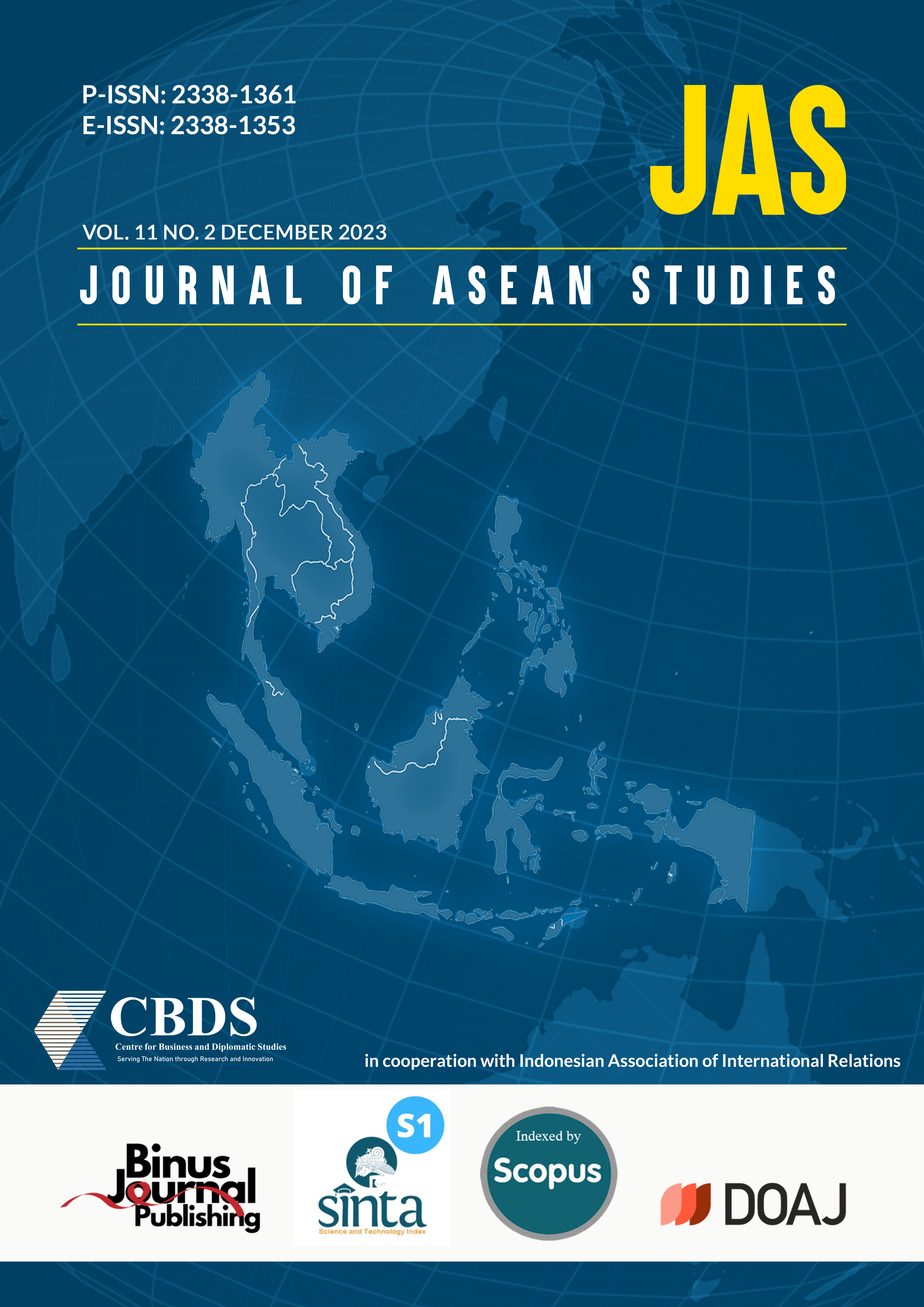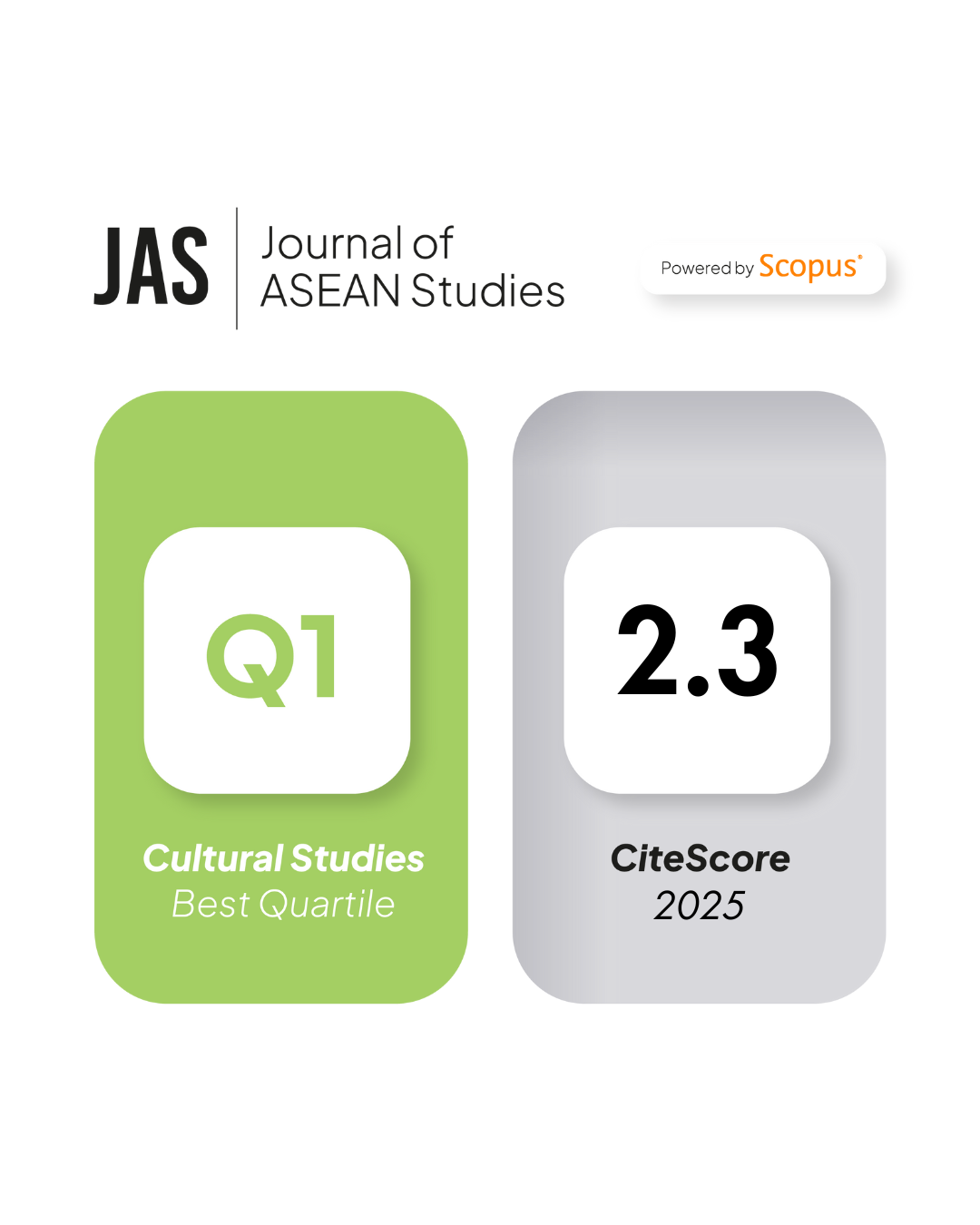A Conceptual Framework of Mobile Payment System Adoption and Use in Southeast Asia
DOI:
https://doi.org/10.21512/jas.v11i2.8815Keywords:
mobile payment, security, risk, trust, attitude, financial incentivesAbstract
The research aims to investigate the factors affecting consumers' adoption and use of Mobile Payment Systems (MPS) in Southeast Asia. Extant theoretical models need to be extended to cover the unique features of mobile payment technology. A Systematic Literature Review (SLR) is conducted to analyse theoretical models utilized to predict the adoption and use of mobile payment. A total of 60 studies about adoption and use of MPS is analysed. The results of the investigations employ the Technology Acceptance Model (TAM), Unified Theory of Acceptance and Use of Technology (UTAUT), and Diffusion of Innovation model (IDT). It reveals that there are inconsistencies in determinants of behavioral intention to adopt and use MPS. Among them are performance expectancy, effort expectancy, and social influence. The review also unveils the use of other determinants to predict behavioral intention to adopt and use MPS, such as perceived security, perceived risks, perceived trust, attitude, and financial incentives to lure new users. The researchers propose a conceptual framework for MPS adoption and use that includes four moderators: gender, age, educational level, and income level. The research contributes to the theory and practice by explicating relevant factors predicting behavioral intention to adopt and use mobile payment in the ASEAN region. Moreover, the SLR offers opportunities for future investigations.
References
Agarwal, S., Chakravorti, S., & Lunn, A. (2010, November). Why do banks reward their customers to use their credit cards? Federal Reserve Bank of Chicago. https://www.chicagofed.org/publications/working-papers/2010/wp-19
Ajzen, I, & Fishbein, M. (1980). Understanding attitudes and predicting social behavior. Prentice-Hall.
Ajzen, I. (1985). From intentions to actions: A theory of planned behavior. In J. Kuhl & J. Beckmann (Eds.), Action control (pp. 11–39). Springer. https://link.springer.com/chapter/10.1007/978-3-642-69746-3_2
Arango, C., Huynh, K. P., & Sabetti, L. (2015). Consumer payment choice: Merchant card acceptance versus pricing incentives. Journal of Banking & Finance, 55, 130–141. https://doi.org/10.1016/j.jbankfin.2015.02.005
Arenas-Gaitán, J., Peral-Peral, B., & Ramón-Jerónimo, M. A. (2015). Elderly and Internet banking: An application of UTAUT2. Journal of Internet Banking and Commerce, 20(1), 1–23.
Au, Y. A., & Kauffman, R. J. (2008). The economics of mobile payments: Understanding stakeholder issues for an emerging financial technology application. Electronic Commerce Research and Applications, 7(2), 141–164. https://doi.org/10.1016/j.elerap.2006.12.004
Baptista, G., & Oliveira, T. (2015). Understanding mobile banking: The unified theory of acceptance and use of technology combined with cultural moderators. Computers in Human Behavior, 50, 418–430. https://doi.org/10.1016/j.chb.2015.04.024
Beutin, N., & Harmsen, M. (2019). Mobile payment report 2019. PwC. https://www.pwc.de/de/digitale-transformation/mobile-payment-report-2019.pdf
Carbó-Valverde, S., & Liñares-Zegarra, J. M. (2011). How effective are rewards programs in promoting payment card usage? Empirical evidence. Journal of Banking and Finance, 35(12), 3275–3291. https://doi.org/10.1016/j.jbankfin.2011.05.008
Chandra, S., Srivastava, S. C., & Theng, Y. L. (2010). Evaluating the role of trust in consumer adoption of mobile payment systems: An emperical analysis. Communications of the Association for Information Systems, 27, 561–588. https://doi.org/10.17705/1CAIS.02729
Chaudhuri, R., Galvin, J., Sattanathan, B., Sunmugam, C., & Thomas, R. (2022, May 25). Mobile wallets: Southeast Asia’s new digital life hack. McKinsey & Company. https://www.mckinsey.com/~/media/mckinsey/industries/financial services/our insights/mobile wallets southeast asias new digital life hack/mobile-wallets-southeast-asias-new-digital-life-hack.pdf?shouldIn
Cheh, S. (2022, April 27). How ecommerce is propelling Southeast Asia’s payments scene to new heights. Tech in Asia. https://www.techinasia.com/ecommerce-propelling-southeast-asias-payments-scene-heights
Cheung, M. C. (2022, May 9). Southeast Asia digital users forecast 2022. Insider Intelligence. https://www.insiderintelligence.com/content/southeast-asia-digital-users-forecast-2022
Dahlberg, T., Mallat, N., Ondrus, J., & Zmijewska, A. (2008). Past, present and future of mobile payments research: A literature review. Electronic Commerce Research and Applications, 7(2), 165–181. https://doi.org/10.1016/j.elerap.2007.02.001
Davies, J., Foxall, G. R., & Pallister, J. (2002). Beyond the intention-behaviour mythology: An integrated model of recycling. Marketing Theory, 2(1), 29–113. https://doi.org/10.1177/1470593102002001645
Davis, F. D. (1985). A technology acceptance model for empirically testing new end-user information systems: Theory and results. Massachusetts Institute of Technology.
Davis, F. D. (1989). Perceived usefulness, perceived ease of use, and user acceptance of information technology. MIS Quarterly, 13(3), 319–340. https://doi.org/10.2307/249008
De Luna, I. R., Liébana-Cabanillas, F., Sánchez-Fernández, J., & Muñoz-Leiva, F. (2019). Mobile payment is not all the same: The adoption of mobile payment systems depending on the technology applied. Technological Forecasting and Social Change, 146, 931–944. https://doi.org/10.1016/j.techfore.2018.09.018
Di Pietro, L., Mugion, R. G., Mattia, G., Renzi, M. F., & Toni, M. (2015). The Integrated Model on Mobile Payment Acceptance (IMMPA): An empirical application to public transport. Transportation Research Part C: Emerging Technologies, 56, 463–479. https://doi.org/10.1016/j.trc.2015.05.001
Dixit, S., Badgaiyan, A. J., & Khare, A. (2019). An integrated model for predicting consumer’s intention to write online reviews. Journal of Retailing and Consumer Services, 46, 112–120. https://doi.org/10.1016/j.jretconser.2017.10.001
Fishbein, M., & Ajzen, I. (1975). Belief, attitude, intention and behaviour: An introduction to theory and research. Addison-Wesley Publishing Company.
Francisco, L. C., Francisco, M. L., & Juan, S. F. (2015). Payment systems in new electronic environments: Consumer behavior in payment systems via SMS. International Journal of Information Technology & Decision Making, 14(2), 421–449. https://doi.org/10.1142/S0219622015500078
Gomber, P., Koch, J. A., & Siering, M. (2017). Digital finance and FinTech: Current research and future research directions. Journal of Business Economics, 87, 537–580. https://doi.org/10.1007/s11573-017-0852-x
Harris, M. A., Chin, A. G., & Beasley, J. (2019). Mobile payment adoption: An empirical review and opportunities for future research. In Proceedings of the Southern Association for Information Systems Conference.
Hidayanto, A. N., Hidayat, L. S., Sandhyaduhita, P. I., & Handayani, P. W. (2015). Examining the relationship of payment system characteristics and behavioural intention in e-payment adoption: a case of Indonesia. International Journal of Business Information Systems, 19(1), 58–86. https://doi.org/10.1504/IJBIS.2015.069065
International Trade Administration. (2020). Indonesia E-Wallet Market. https://www.trade.gov/market-intelligence/indonesia-e-wallet-market
Jakarta Post. (2019, August 14). The top five e-wallet apps in Indonesia. The Jakarta Post. https://www.thejakartapost.com/life/2019/08/14/the-top-five-e-wallet-apps-in-indonesia.html
Jaradat, M. I. R. M., & Al-Mashaqba, A. M. (2014). Understanding the adoption and usage of mobile payment services by using TAM3. Intermational Journal of Business Information Systems, 16(3), 271–296. https://doi.org/10.1504/IJBIS.2014.063768
Karim, M. F., Mursitama, T. N., & Arnakim, L. Y. (2022). Deepening connectivity and mobility in post-pandemic ASEAN. Journal of ASEAN Studies, 10(1). https://doi.org/10.21512/jas.v10i1.8868
Kaur, D. (2021, November 17). Here’s why Southeast Asia is a digital payment powerhouse. Techwire Asia. https://techwireasia.com/2021/11/heres-why-southeast-asia-is-a-digital-payment-powerhouse/
Khalilzadeh, J., Ozturk, A. B., & Bilgihan, A. (2017). Security-related factors in extended UTAUT model for NFC based mobile payment in the restaurant industry. Computers in Human Behavior, 70, 460–474. https://doi.org/10.1016/j.chb.2017.01.001
Kim, K. (2022). Key features of Indonesia’s state capitalism under Jokowi. Journal of ASEAN Studies, 10(2), 207–226. https://doi.org/10.21512/jas.v10i2.9075
Kitchenham, B. (2007). Guidelines for performing systematic literature reviews in software engineering. EBSE Technical Report EBSE, 1–57.
Kitchenham, B., Pearl Brereton, O., Budgen, D., Turner, M., Bailey, J., & Linkman, S. (2009). Systematic literature reviews in software engineering - A systematic literature review. Information and Software Technology, 51(1), 7–15. https://doi.org/10.1016/j.infsof.2008.09.009
Koenig-Lewis, N., Marquet, M., Palmer, A., & Zhao, A. L. (2015). Enjoyment and social influence: Predicting mobile payment adoption. Service Industries Journal, 35(10), 537–554. https://doi.org/10.1080/02642069.2015.1043278
Lai, P. C. (2017). Security as an extension to TAM model: Consumers’ intention to use a single platform e-payment. Asia-Pacific Journal of Management Research and Innovation, 13(3–4), 110–119. https://doi.org/10.1177/2319510x18776405
Liébana-Cabanillas, F., Muñoz-Leiva, F., & Sánchez-Fernández, J. (2013). The impact of risk on the technological acceptance of mobile payment services. Global Business Perspectives, 1, 309–328. https://doi.org/10.1007/s40196-013-0020-9
Liébana-Cabanillas, F., Nogueras, R., Herrera, L. J., & Guillén, A. (2013). Analysing user trust in electronic banking using data mining methods. Expert Systems with Applications, 40(14), 5439–5447. https://doi.org/10.1016/j.eswa.2013.03.010
Liébana-Cabanillas, F., Ramos de Luna, I., & Montoro-RÃos, F. J. (2015). User behaviour in QR mobile payment system: The QR payment acceptance model. Technology Analysis & Strategic Management, 27(9), 1031–1049. https://doi.org/10.1080/09537325.2015.1047757
Liébana-Cabanillas, F., Sánchez-Fernández, J., & Muñoz-Leiva, F. (2014). Antecedents of the adoption of the new mobile payment systems: The moderating effect of age. Computers in Human Behavior, 35, 464–478. https://doi.org/10.1016/j.chb.2014.03.022
Lim, Y. J., Osman, A., Salahuddin, S. N., Romle, A. R., & Abdullah, S. (2016). Factors influencing online shopping behavior: The mediating role of purchase intention. Procedia Economics and Finance, 35, 401–410. https://doi.org/10.1016/S2212-5671(16)00050-2
Limantara, N., Jingga, F., & Surja, S. (2018). Factors influencing mobile payment adoption in Indonesia. In 2018 International Conference on Information Management and Technology (ICIMTech) (pp. 373–377). IEEE. https://doi.org/10.1109/ICIMTech.2018.8528143
Manaf, N. R., & Ariyanti, M. (2017). Exploring key factors on technology acceptance of mobile payment users in Indonesia using modified Unified Theory of Acceptance and Use of Technology (UTAUT) model use case: ABC Easy Tap. International Journal of Management and Applied Science, 3(1), 40–44.
Marmaya, N. H., Zakaria, Z., & Mohd Desa, M. N. (2019). Gen Y consumers’ intention to purchase halal food in Malaysia: A PLS-SEM approach. Journal of Islamic Marketing, 10(3), 1003–1014. https://doi.org/10.1108/JIMA-08-2018-0136
Mishal, A., Dubey, R., Gupta, O. K., & Luo, Z. (2017). Dynamics of environmental consciousness and green purchase behaviour: An empirical study. International Journal of Climate Change Strategies and Management, 9(5), 682–706. https://doi.org/10.1108/IJCCSM-11-2016-0168
Mitra, S., & Mittal, S. (2020, September 3). Why it may be hard for e-wallets in Indonesia to transform into super apps. Tech in Asia. https://www.techinasia.com/ewallets-battling-superapp-crown
Molina-Castillo, F. J., Lopez-Nicolas, C., & De Reuver, M. (2020). Mobile payment: The hiding impact of learning costs on user intentions. Journal of Theoretical and Applied Electronic Commerce Research, 15(1), 1–12. https://doi.org/10.4067/S0718-18762020000100102
Morosan, C., & DeFranco, A. (2016). It’s about time: Revisiting UTAUT2 to examine consumers’ intentions to use NFC mobile payments in hotels. International Journal of Hospitality Management, 53, 17–29. https://doi.org/10.1016/j.ijhm.2015.11.003
Pal, D., Vanijja, V., & Papasratorn, B. (2015). An empirical analysis towards the adoption of NFC mobile payment system by the end user. Procedia Computer Science, 69, 13–25. https://doi.org/10.1016/j.procs.2015.10.002
Patil, P., Tamilmani, K., Rana, N. P., & Raghavan, V. (2020). Understanding consumer adoption of mobile payment in India: Extending Meta-UTAUT model with personal innovativeness, anxiety, trust, and grievance redressal. International Journal of Information Management, 54. https://doi.org/10.1016/j.ijinfomgt.2020.102144
Rana, N. P., Dwivedi, Y. K., Williams, M. D., & Weerakkody, V. (2016). Adoption of online public grievance redressal system in India: Toward developing a unified view. Computers in Human Behavior, 59, 265–282. https://doi.org/10.1016/j.chb.2016.02.019
Ramos-de-Luna, I., Montoro-RÃos, F., & Liébana-Cabanillas, F. (2016). Determinants of the intention to use NFC technology as a payment system: An acceptance model approach. Information Systems and E-Business Management, 14, 293–314. https://doi.org/10.1007/s10257-015-0284-5
Rogers, E. M., Singhal, A., & Quinlan, M. M. (2003). Diffusion of Innovations. An Integrated Approach tocommunication Theory and Research.
Shankar, A., & Datta, B. (2018). Factors affecting mobile payment adoption intention: An Indian perspective. Global Business Review, 19(3_suppl), S72–S89. https://doi.org/10.1177/0972150918757870
Shao, Z., Zhang, L., Li, X., & Guo, Y. (2019). Antecedents of trust and continuance intention in mobile payment platforms: The moderating effect of gender. Electronic Commerce Research and Applications, 33. https://doi.org/10.1016/j.elerap.2018.100823
Slade, E. L., Williams, M. D., & Dwivedi, Y. K. (2013). Extending UTAUT2 to explore consumer adoption of mobile payments. In UK Academy for Information Systems Conference Proceedings. http://aisel.aisnet.org/ukais2013/36/
Slade, E., Williams, M., Dwivedi, Y., & Piercy, N. (2015). Exploring consumer adoption of proximity mobile payments. Journal of Strategic Marketing, 23(3), 209–223. https://doi.org/10.1080/0965254x.2014.914075
Syahputera, R. (2019, January 15). How mobile payment giants in Indonesia can quit the subsidy rat race. Convergence Ventures. https://www.convergencevc.com/how-mobile-payment-giants-in-indonesia-can-quit-the-subsidy-rat-race/
Tani, S. (2019, June 1). Cash-burning Indonesian payment apps seek profit in credit. Nikkei Asia. https://asia.nikkei.com/Business/Startups/Cash-burning-Indonesian-payment-apps-seek-profit-in-credit
The Asian Business Review. (2021). SEA named world’s fastest-growing mobile wallet region. https://asianbusinessreview.com/news/sea-named-worlds-fastest-growing-mobile-wallet-region
Thompson, R. L., Higgins, C. A., & Howell, J. M. (1991). Personal computing: Toward a conceptual model of utilization. MIS Quarterly, 15(1), 125-143. https://doi.org/10.2307/249443
Ting, H., Yacob, Y., Liew, L., & Lau, W. M. (2016). Intention to use mobile payment system: A case of developing market by ethnicity. Procedia - Social and Behavioral Sciences, 224, 368–375. https://doi.org/10.1016/j.sbspro.2016.05.390
Triandis, H. C. (1979). Values, attitudes, and interpersonal behavior. Nebraska Symposium on Motivation, 27, 195–259. https://psycnet.apa.org/record/1982-21073-001
Venkatesh, V., & Bala, H. (2008). Technology acceptance model 3 and a research agenda on interventions. Decision Sciences, 39(2), 273–315. https://doi.org/10.1111/j.1540-5915.2008.00192.x
Venkatesh, V., Morris, M. G., Davis, G. B., & Davis, F. D. (2003). User acceptance of information technology: Toward a unified view. MIS Quarterly, 27(3), 425–478. https://doi.org/10.2307/30036540
Venkatesh, V., Thong, J. Y. L., & Xu, X. (2012). Consumer acceptance and use of information technology: Extending the unified theory of acceptance and use of technology. MIS Quarterly, 36(1), 157–178. https://doi.org/10.2307/41410412
VISA. (2022). Consumer payment attitudes study 2022 -Navigating a new era in payment. https://www.visa.co.th/dam/VCOM/regional/ap/documents/visa-cpa-report-smt-2022.pdf
Wang, J., & Lai, J. Y. (2020). Exploring innovation diffusion of two-sided mobile payment platforms: A system dynamics approach. Technological Forecasting and Social Change, 157. https://doi.org/10.1016/j.techfore.2020.120088
Wang, L., & Dai, X. (2020). Exploring factors affecting the adoption of mobile payment at physical stores. International Journal of Mobile Communications, 18(1), 67–82. https://doi.org/10.1504/ijmc.2020.104420
Wang, Y., Sun, S., Lei, W., & Toncar, M. (2009). Examining beliefs and attitudes toward online advertising among Chinese consumers. Direct Marketing: An International Journal, 3(1), 52–66. https://doi.org/10.1108/17505930910945732
Williams, M. D., Roderick, S., Davies, G. H., & Clement, M. (2017). Risk, trust, and compatibility as antecedents of mobile payment adoption. In AMCIS 2017 Proceedings. https://pdfs.semanticscholar.org/6e9a/74a702a7dd2fe0747544b359901bbe66344b.pdf
Yang, S., Lu, Y., Gupta, S., Cao, Y., & Zhang, R. (2012). Mobile payment services adoption across time: An empirical study of the effects of behavioral beliefs, social influences, and personal traits. Computers in Human Behavior, 28(1), 129–142. https://doi.org/10.1016/j.chb.2011.08.019
Yeh, H. (2020). Factors in the ecosystem of mobile payment affecting its use: From the customers’ perspective in Taiwan. Journal of Theoretical and Applied Electronic Commerce Research, 15(1), 13–29. https://doi.org/10.4067/S0718-18762020000100103
Yeh, M. L., & Tseng, Y. L. (2017). The college students’ behavior intention of using mobile payments in taiwan: An exploratory research. In Proceedings of IASTEM International Conference. http://www.worldresearchlibrary.org/up_proc/pdf/652-14876681932-6.pdf
Zhao, H. (2017). The effect of financial incentives on nfc mobile payment adoption. The University of Georgia. https://getd.libs.uga.edu/pdfs/zhao_haidong_201712_phd.pdf
Zhao, H., Anong, S. T., & Zhang, L. (2019). Understanding the impact of financial incentives on NFC mobile payment adoption: An experimental analysis. International Journal of Bank Marketing, 37(5), 1296–1312. https://doi.org/10.1108/IJBM-08-2018-0229
Zhou, T. (2011). The effect of initial trust on user adoption of mobile payment. Information Development, 27(4), 290–300. https://doi.org/10.1177/0266666911424075
Downloads
Published
How to Cite
Issue
Section
License
Copyright (c) 2023 Andreas Chang, Theresia Gunawan, Ujang Sumarwan

This work is licensed under a Creative Commons Attribution-NonCommercial 4.0 International License.






















